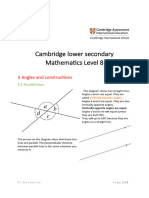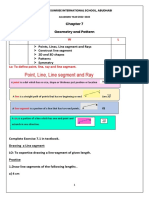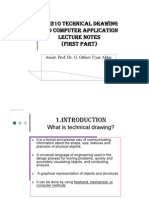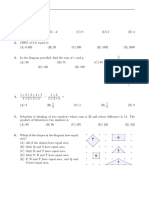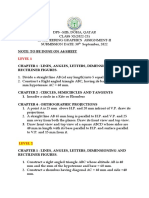Folding 2D Paper Polygons
Folding 2D Paper Polygons
Uploaded by
mathcuriousCopyright:
Available Formats
Folding 2D Paper Polygons
Folding 2D Paper Polygons
Uploaded by
mathcuriousOriginal Description:
Copyright
Available Formats
Share this document
Did you find this document useful?
Is this content inappropriate?
Copyright:
Available Formats
Folding 2D Paper Polygons
Folding 2D Paper Polygons
Uploaded by
mathcuriousCopyright:
Available Formats
Folding 2D Paper Shapes
Folding Paper Shapes
The following diagrams are not to scale but are intended as a rough guide.
All start with standard “A” sized paper. Red lines are fold lines. Green lines are
the result of previous folds or where an edge of original paper lies on top of
current shape.
Triangle A – Isosceles
Triangle B – Isosceles
Triangle C - Equilateral
J Button 2002 Page 1 of 5
Folding 2D Paper Shapes
Kite A
Kite B
Parallelogram
Fold both flaps up.
J Button 2002 Page 2 of 5
Folding 2D Paper Shapes
Trapezium A
Trapezium B – Isosceles
Rhombus
A
Fold in half to make crease. Unfold and
fold each edge in to centre crease.
Unfold. You should have 3 creases
showing and 4 equal sections.
Fold vertex A down onto crease line and repeat with vertex B, so central crease
is a line of symmetry.
B C
Fold vertex C to lie
on sloping edge (and
A repeat with vertex
D to obtain the
C D
D rhombus)
J Button 2002 Page 3 of 5
Folding 2D Paper Shapes
Pentagon A
Pentagon B – almost regular
Top flap only
Tuck bottom flap under same
fold line.
Open out on fold line.
Hexagon
Make the rhombus as above then fold vertices at ends of longest diagonal in to
the central crease to complete your hexagon.
J Button 2002 Page 4 of 5
Folding 2D Paper Shapes
Lesson ideas
Use the various polygons to explore lines of symmetry.
Don’t forget to include a square and rectangle to reinforce that rectangles only have two lines of
symmetry.
Use two of each polygon to explore rotational symmetry
Use several isosceles triangle A's to produce other polygons. How many different ones can you make
and name.
Create a flow diagram / decision tree to categorise each of the polygons.
Calculate the angles of each polygon.
Calculate the edge lengths of each polygon.
What dimension paper would you need to start with so that all of the polygons had the same area?
Use 3 of the rhombus shape to create a representation of a cube.
What would the volume of the cube be?
Explore various impossible geometry figures made using the rhombus
http://www.origomath.com/media/pdf/samples_books/geo/geo_paperpolygons_sample.pdf
J Button 2002 Page 5 of 5
You might also like
- Shape Pop-Up BookDocument2 pagesShape Pop-Up Bookrafizah.osmanNo ratings yet
- Crane e A4Document0 pagesCrane e A4DikacukNo ratings yet
- Angles in PolygonsDocument9 pagesAngles in Polygonsapi-233663523No ratings yet
- Area of Regular PolygonsDocument2 pagesArea of Regular PolygonsFady NagyNo ratings yet
- 01-The Best Advanced Paper Aircraft Book 1Document99 pages01-The Best Advanced Paper Aircraft Book 1Dang Anh Duy100% (1)
- Foca A4Document4 pagesFoca A4Anonymous 2yahBPfNo ratings yet
- Crane Folding DirectionsDocument2 pagesCrane Folding DirectionsBrandon LoNo ratings yet
- Chinese Paper FoldingDocument135 pagesChinese Paper Foldinghyung-woo limNo ratings yet
- DevelopmentDocument15 pagesDevelopmentภเՇץค 555No ratings yet
- Origami Series Frog: (Page 1)Document5 pagesOrigami Series Frog: (Page 1)AzuletaLaBallenaNo ratings yet
- Development of SurfacesDocument15 pagesDevelopment of SurfacesFatima KhalidNo ratings yet
- Cambridge Lower Secondary Mathematics Level 8 Unit 3Document9 pagesCambridge Lower Secondary Mathematics Level 8 Unit 3عالم الضحك100100% (1)
- TPC 2Document21 pagesTPC 2mukona199No ratings yet
- Deco Star Model by José Meeusen 2-24-1994 Diagram by Jorge Jaramillo 2018Document2 pagesDeco Star Model by José Meeusen 2-24-1994 Diagram by Jorge Jaramillo 2018Ezra BlatzNo ratings yet
- Origami Series Iris: (Page 1)Document5 pagesOrigami Series Iris: (Page 1)Andrea Campos MoralesNo ratings yet
- Folded Combined Planes PDFDocument67 pagesFolded Combined Planes PDFankasbilenkaNo ratings yet
- Apron PatternDocument2 pagesApron PatternactualT100% (10)
- Topic F. Angles and Construction of DiagramsDocument18 pagesTopic F. Angles and Construction of Diagramslikad9730No ratings yet
- Chapter09 Geometric FiguresDocument32 pagesChapter09 Geometric Figureslen16328100% (4)
- Student Version MATH 2044 Lecture 13 15 Solid GeometryDocument68 pagesStudent Version MATH 2044 Lecture 13 15 Solid GeometryxavieraganimNo ratings yet
- in MathDocument27 pagesin MathJhezmae Rose Pasion AlonzoNo ratings yet
- Final Exam in DraftingDocument4 pagesFinal Exam in DraftingAbegail Capunong PasigadoNo ratings yet
- Grade 3 Geometry NotesDocument5 pagesGrade 3 Geometry NotesSimna BijuNo ratings yet
- Technical DrawingDocument58 pagesTechnical Drawingamacarras95% (21)
- 3D - Geometry Notes and Lesson 7th GradeDocument31 pages3D - Geometry Notes and Lesson 7th GradeMichael Edward Nepomuceno DeVillaNo ratings yet
- Grade 6 GeometryDocument6 pagesGrade 6 GeometryNguyen Thi Thien MinhNo ratings yet
- How To Make A 5-Pointed Star - : Geometric Design - DecagonsDocument1 pageHow To Make A 5-Pointed Star - : Geometric Design - DecagonsZyril Faith TapingNo ratings yet
- Leong Cheng Chit - December 1999Document5 pagesLeong Cheng Chit - December 1999Karina Astucuri FishNo ratings yet
- What Are You Going To Learn?: Drawing Right Triangles, Isosceles Triangles and Equilateral TrianglesDocument8 pagesWhat Are You Going To Learn?: Drawing Right Triangles, Isosceles Triangles and Equilateral TrianglesF X AGUS SISWANTONo ratings yet
- Folding and one straight cut sufficeDocument2 pagesFolding and one straight cut sufficeSallie HollanderNo ratings yet
- Topic 2: Geometrical ConstructionDocument16 pagesTopic 2: Geometrical ConstructionEmir Emir SyaminNo ratings yet
- Heep 206Document42 pagesHeep 206Bodhisatya BhattacharjeeNo ratings yet
- Visualizing Solid Shapes PDFDocument42 pagesVisualizing Solid Shapes PDFAshishNo ratings yet
- Simulate-A-City - Trafalgar Edition 2020 - Instruction ManualDocument15 pagesSimulate-A-City - Trafalgar Edition 2020 - Instruction ManualGia MacCallumNo ratings yet
- Simulate-A-City - Trafalgar Edition 2020 - Instruction ManualDocument15 pagesSimulate-A-City - Trafalgar Edition 2020 - Instruction ManualGia MacCallumNo ratings yet
- 14 Mensuration of Plane Figures PDFDocument10 pages14 Mensuration of Plane Figures PDFAllen Kyle PrielaNo ratings yet
- Basic Concepts of GeometryDocument94 pagesBasic Concepts of GeometryJessie GalorioNo ratings yet
- TJP Top Tips: Igcse Shape & SpaceDocument24 pagesTJP Top Tips: Igcse Shape & SpaceChrystal BrownNo ratings yet
- Development of Surface Engineering Graphics and FabricationsDocument10 pagesDevelopment of Surface Engineering Graphics and Fabricationstanmayjoshi043No ratings yet
- Paper Folding DiscoveryDocument3 pagesPaper Folding Discoveryapi-253005231No ratings yet
- 470 - Mce 101 Introduction To Engineering DrawingsDocument15 pages470 - Mce 101 Introduction To Engineering DrawingsADAMU MUSA SANINo ratings yet
- 1 Ea 7623822Document8 pages1 Ea 7623822Saadia AnjumNo ratings yet
- Class 5Document9 pagesClass 5amrithakhubaNo ratings yet
- IGCSE Shape SpaceDocument24 pagesIGCSE Shape Spacedemiyang030No ratings yet
- Gambar Bentangan enDocument13 pagesGambar Bentangan enAndrea Mega PutraNo ratings yet
- Math5 q3 Module3 Week3Document6 pagesMath5 q3 Module3 Week3Avelino Coballes IVNo ratings yet
- JHS DemoDocument21 pagesJHS DemoAngel AlibangbangNo ratings yet
- Development of Surfaces of Solids.: What Is Our Objective in This Topic ?Document9 pagesDevelopment of Surfaces of Solids.: What Is Our Objective in This Topic ?ShivaniNo ratings yet
- Section2FoldedRelease1Document67 pagesSection2FoldedRelease1mahixit749No ratings yet
- Grade 9 3rd QuarterDocument13 pagesGrade 9 3rd QuarterElija Fernan De JesusNo ratings yet
- Module 2 - Geometry of Shape and Size-1Document21 pagesModule 2 - Geometry of Shape and Size-1bernadeth villanuevaNo ratings yet
- 8 9 Week1 Math Geometry1Document21 pages8 9 Week1 Math Geometry1PRIMARY HEALTH CENTER SINORNo ratings yet
- JSS2 Scheme of WorkDocument18 pagesJSS2 Scheme of WorkAbdullateef AdedoyinNo ratings yet
- Atlas V: Paper Model KitDocument19 pagesAtlas V: Paper Model KitJefferson Matheus100% (1)
- Competition Make and Origami Moon Just After MidnightDocument1 pageCompetition Make and Origami Moon Just After MidnightPriyanka KarunakaranNo ratings yet
- Polygon Vocabulary. Triangle VocabularyDocument7 pagesPolygon Vocabulary. Triangle VocabularyBill Laulo100% (1)
- Origami Spectacular! Ebook: Origami Book, 154 Printable Papers, 60 ProjectsFrom EverandOrigami Spectacular! Ebook: Origami Book, 154 Printable Papers, 60 ProjectsRating: 4.5 out of 5 stars4.5/5 (2)
- Origami City Ebook: Build Your Own Cars, Trucks, Planes & Trains!: Contains Full Color 48 Page Origami Book, 12 Projects and Printable Origami PapersFrom EverandOrigami City Ebook: Build Your Own Cars, Trucks, Planes & Trains!: Contains Full Color 48 Page Origami Book, 12 Projects and Printable Origami PapersNo ratings yet
- Origami Dinosaur: Prehistoric Fun for Everyone!: Origami Book with 20 Fun Projects and Printable Origami Papers: Great for Kids and ParentsFrom EverandOrigami Dinosaur: Prehistoric Fun for Everyone!: Origami Book with 20 Fun Projects and Printable Origami Papers: Great for Kids and ParentsRating: 4.5 out of 5 stars4.5/5 (2)
- About Folded and Crumpled Models in NatureDocument8 pagesAbout Folded and Crumpled Models in NatureWilliam DriepuntnulNo ratings yet
- Math 7: Quarter 3 Week 9 Unified Supplementary Learning Material #9Document8 pagesMath 7: Quarter 3 Week 9 Unified Supplementary Learning Material #9Akane Rose HitomiNo ratings yet
- PC FinalDocument58 pagesPC FinalAnurag SrivastavNo ratings yet
- Module Overview: Mathematics As The Study of Patterns)Document15 pagesModule Overview: Mathematics As The Study of Patterns)hi ilyNo ratings yet
- 2013 - Textile Materials and Structures With Negative Poissons Ratio - An OverviewDocument19 pages2013 - Textile Materials and Structures With Negative Poissons Ratio - An OverviewSubramani PichandiNo ratings yet
- Market risk analysis III Pricing hedging and trading financial instruments 2024 scribd downloadDocument24 pagesMarket risk analysis III Pricing hedging and trading financial instruments 2024 scribd downloadmemisrixenvlNo ratings yet
- Hexagonal Spell Templates: by ZinoviaDocument11 pagesHexagonal Spell Templates: by ZinoviaLuke Reed100% (1)
- Question Bank - 11Document80 pagesQuestion Bank - 11Eng.Basem AlHussienNo ratings yet
- Questions - Intermediate DivisionDocument17 pagesQuestions - Intermediate Divisionjkjigij100% (1)
- Chapt 6.1 and TesselationDocument14 pagesChapt 6.1 and TesselationJochebedShealeC.BalandraNo ratings yet
- Inclusion ExclusionDocument4 pagesInclusion ExclusionFantastiqueFessesNo ratings yet
- Grade 10 Maths WK 3 PDFDocument4 pagesGrade 10 Maths WK 3 PDFBitania SolomonNo ratings yet
- Math Reviewer Exam SampleDocument2 pagesMath Reviewer Exam SampleEugene CardamaNo ratings yet
- Wajo 18 QnsolnDocument16 pagesWajo 18 QnsolnSmpnsatubontang KaltimNo ratings yet
- Section of Solids 240416Document11 pagesSection of Solids 240416Nagaraj MuniyandiNo ratings yet
- Lecture - 6: Orthographic Views of Frustum & Truncated SolidsDocument43 pagesLecture - 6: Orthographic Views of Frustum & Truncated SolidsMuhammad Ridwanul Islam100% (1)
- Exam Style Questions: GuidanceDocument14 pagesExam Style Questions: GuidanceediealiNo ratings yet
- Lines of Symmetry For Regular PolygonsDocument13 pagesLines of Symmetry For Regular Polygonsnimisha lathiffNo ratings yet
- Engineering Drawing Unit - IDocument189 pagesEngineering Drawing Unit - IK S Chalapathi100% (1)
- Geometry Questions Bank PDF For CAT 1990 To 2018 PDFDocument81 pagesGeometry Questions Bank PDF For CAT 1990 To 2018 PDFSPOORTHY STUDY CIRCLENo ratings yet
- 11 Non Verbal Reasoning TestsDocument130 pages11 Non Verbal Reasoning TestsAnkit Sharma67% (3)
- Non Verbal Reasoning AnswersDocument7 pagesNon Verbal Reasoning AnswersIsmulianita Djalinas MadjidNo ratings yet
- L3 Surface Area and Volume of Right Prisms Part 1Document23 pagesL3 Surface Area and Volume of Right Prisms Part 1Emerson PaloNo ratings yet
- Primary Mathematics Scheme of Work: Stage 4Document17 pagesPrimary Mathematics Scheme of Work: Stage 4Danielle100% (1)
- Assignment-2 Egxi202223Document3 pagesAssignment-2 Egxi202223SHUBHAMNo ratings yet
- Properties of Regular PentagonsDocument3 pagesProperties of Regular PentagonshimanshujainnNo ratings yet
- Answers To Student S Book 3 and Workbook 3Document83 pagesAnswers To Student S Book 3 and Workbook 3khinNo ratings yet
- PracticeBook Maths10Document69 pagesPracticeBook Maths10Pixcasso 21100% (1)











